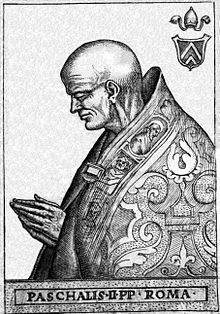Pascal II
|
Pope Paschal II |
|
|---|---|
 |
|
| Papacy began | 13 August 1099 |
| Papacy ended | 21 January 1118 |
| Predecessor | Urban II |
| Successor | Gelasius II |
| Orders | |
| Created Cardinal | 1073 by Gregory VII |
| Personal details | |
| Birth name | Ranierius |
| Born | 1050–55 Bleda, March of Tuscany, Holy Roman Empire |
| Died |
21 January 1118 Rome, Papal States, Holy Roman Empire |
| Previous post |
|
|
Papal styles of Pope Paschal II |
|
|---|---|
 |
|
| Reference style | His Holiness |
| Spoken style | Your Holiness |
| Religious style | Holy Father |
| Posthumous style | none |
Pope Paschal II (Latin: Paschalis II; 1050 x 1055 – 21 January 1118), born Ranierius, was Pope from 13 August 1099 to his death in 1118.
A monk of the Cluniac order, he created the Cardinal-Priest of San Clemente by Pope Gregory VII (1073–85) in 1073. He was consecrated as pope in succession to Pope Urban II (1088–99) on 19 August 1099. His reign of almost twenty years was exceptionally long for a pope of the Middle Ages.
He was born in Bleda, near Forlì, Romagna. In the long struggle with the Holy Roman Emperors over investiture, he zealously carried on the Hildebrandine policy in favor of papal privilege, but with only partial success. The future Emperor Henry V took advantage of his father's excommunication to rebel, even to the point of seeking out Paschal II for absolution for associating with his father, Henry IV. But, Henry V was even more persistent in maintaining the right of investiture than Emperor Henry IV had been before his death in 1106. The imperial Diet at Mainz invited Paschal II to visit Germany and settle the trouble in January 1106, but the Pope in the Council of Guastalla (October 1106) simply renewed the prohibition of investiture.
In the same year he brought to an end the investiture struggle in England, in which Anselm, archbishop of Canterbury, had been engaged with Henry I of England, by retaining to himself exclusive right to invest with the ring and crozier, but recognizing the royal nomination to vacate benefices and the oath of fealty for temporal domains. Paschal went to France at the close of 1106 to seek the mediation of Philip I of France and Prince Louis in the imperial struggle, but he returned to Italy in September 1107, his negotiations remaining without result. When Henry V advanced with an army into Italy in order to be crowned, the Pope agreed to a compact in February 1111 which stipulated that the Church should surrender all the possessions and royalties it had received from the Empire and kingdom of Italy since the days of Charlemagne, while Henry V on his side should renounce lay investiture. Preparations were made for the coronation on 12 February 1111, but the Romans rose in revolt against Henry, and the German king retired, taking the Pope and Curia with him.
...
Wikipedia
